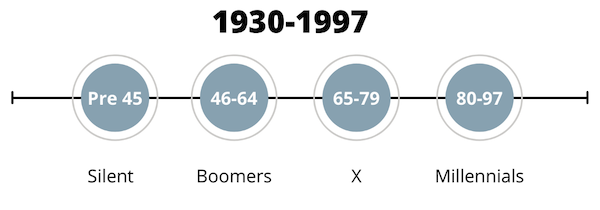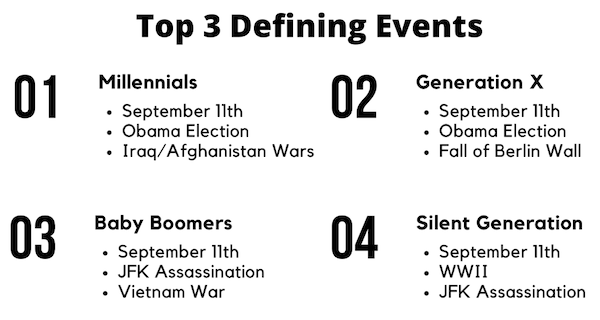Published on
Delivering Online Learning Through the Generations

A number of years ago, I was working in a private financial advisory firm. My boss was a very respected and experienced baby boomer. Every so often he would ask me to call the brokerage company about a certain account: “Call up Schwab and find out about Kent’s account.” I would write down a few notes, nodding my head. 40 minutes later my boss would return. “Did you call about Kent’s account?” he would ask. “I sent an email but have not heard back,” I would say. Fast-forward one hour later. “Did you call?” he asked. “I am chatting with them online right now…” My boss would shake his head. According to LivePerson most millennials prefer to communicate via text rather than on the phone. This is a distinct generational difference. You may have experienced some of these generational differences yourself. This is no surprise since we are looking at—for the first time in history—four generations sharing workplace. There are several things that leaders of adult and continuing education should consider in light of these differences, especially in terms of product offerings for the rising millennial consumer.
To begin, let’s define the current generations in the workplace. I was born in 1980, which means I straddle generations. Depending on who you ask, I am either a Gen Xer or a millennial. With one foot in the analog past and another in the digital present and future, I can identify with both generations, though I tend toward a millennial viewpoint. Although there are so many differing cut off dates for generational cohorts, I have outlined what they generally are below.
- The Silent Generation—born before 1945
- The Baby Boom Generation—born between 1946 and 1964
- Generation X—born between 1965 and 1979
- Millennials—born between 1980 and 1997

Each generation is defined by the historical events that shaped them in early adulthood. In this way, a cohort of people born within a specific time period often have similar worldviews. Consider Pew Research’s survey of defining events by generation. I will summarize the top three for each generation.
- The Silent Generation—9/11, WW2, JFK assassination
- The Baby Boom Generation—9/11, JFK assassination, Vietnam War
- Generation X—9/11, Obama election, fall of the Berlin Wall
- Millennials—9/11, Obama election, Iraq/Afghanistan Wars
While, 9/11 made the list for all four groups, the other defining events vary greatly. These differences shape generational trends and outlooks. With these general guidelines in place, let’s now turn to generational considerations.

One main area of concern for the leaders of continuing and professional education programs is the types of products different generations may want or require. Because millennials are now the largest generation in the workplace, I will focus on their preferences. Many of them prefer online and hybrid learning options. This is not only a preference for technology but also a pragmatic approach to learning.
Consider that millennials are three times more likely to move for a new job than boomers. In other words, mobility counts. Being able to start a program and continue that program when a new job takes them to a new location is important. I remember finding myself in that very situation. During graduate school, I was offered a really good job opportunity in another state. Luckily, I could switch from the brick-and-mortar education option to the hybrid option. I took the job and finished my degree.
Also, consider that constant re-skilling is necessary for all generations but for millennials in particular, who change jobs roughly every 26 months. Long gone are the days of 20-year gold watches and union-negotiated pension funds. In fact, millennials are not just up-skilling for their primary jobs but for prospective new ventures as well. Data from Bankrate suggest that one in four millennials have a side hustle. This change means that programming not only needs to be accessible in online or hybrid formats but that it also must be highly relevant. We conducted a survey of skills needed for MBA graduates at Western Governors University. Topping the list? Leadership, analytics, communications, and innovation–all skills that millennials may already be looking to add to their career arsenal.
One example of the upskilling mentality comes to mind in the form of an Uber trip. While talking to my driver, he told me he was an undergraduate student at WGU. He explained that he studied during his downtime between rides. He was finishing his degree in order to prepare for the next phase of his career. Programs that respond to labor forces will continue to be in demand as long as millennials look to upskill for their next job or side hustle.
But it’s not just online flexibility and relevant programming students are looking for. They also want return on investment. According to GMAC, one of the biggest reservations students have about starting a graduate business program is the need to take on debt. For millennials, this is no small wonder, as they came of age in the great recession of 2008. In response, many MBA programs have now moved online and lowered their price points. Many programs now cost between $20,000 and $30,000, which still may be too much. That’s why at WGU we have created an online MBA that can be completed for about $12,000 in a year and half.
As millennials become the key demographic for adult and continuing higher education programs, programming must shift to meet their needs, through flexible online/hybrid learning modalities, relevant market aligned content, and affordable price points.
Author Perspective: Administrator


